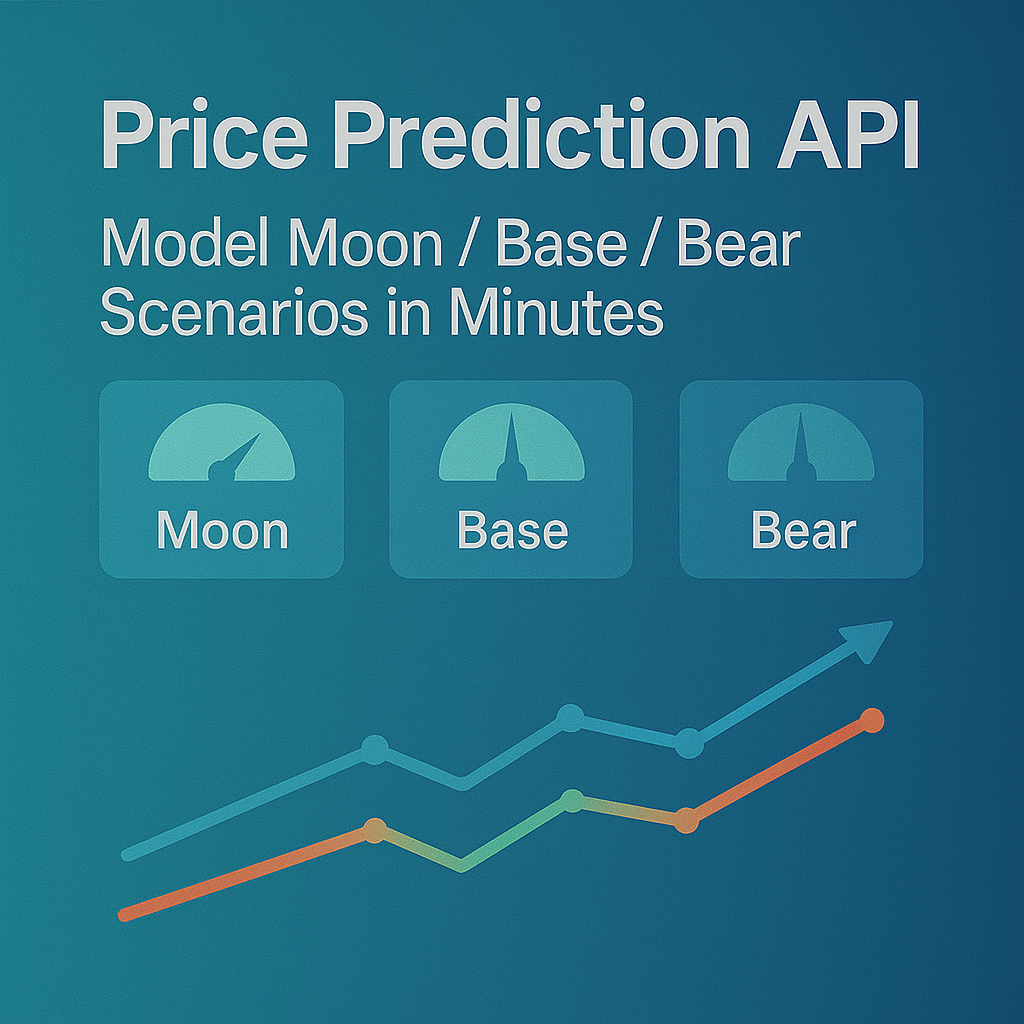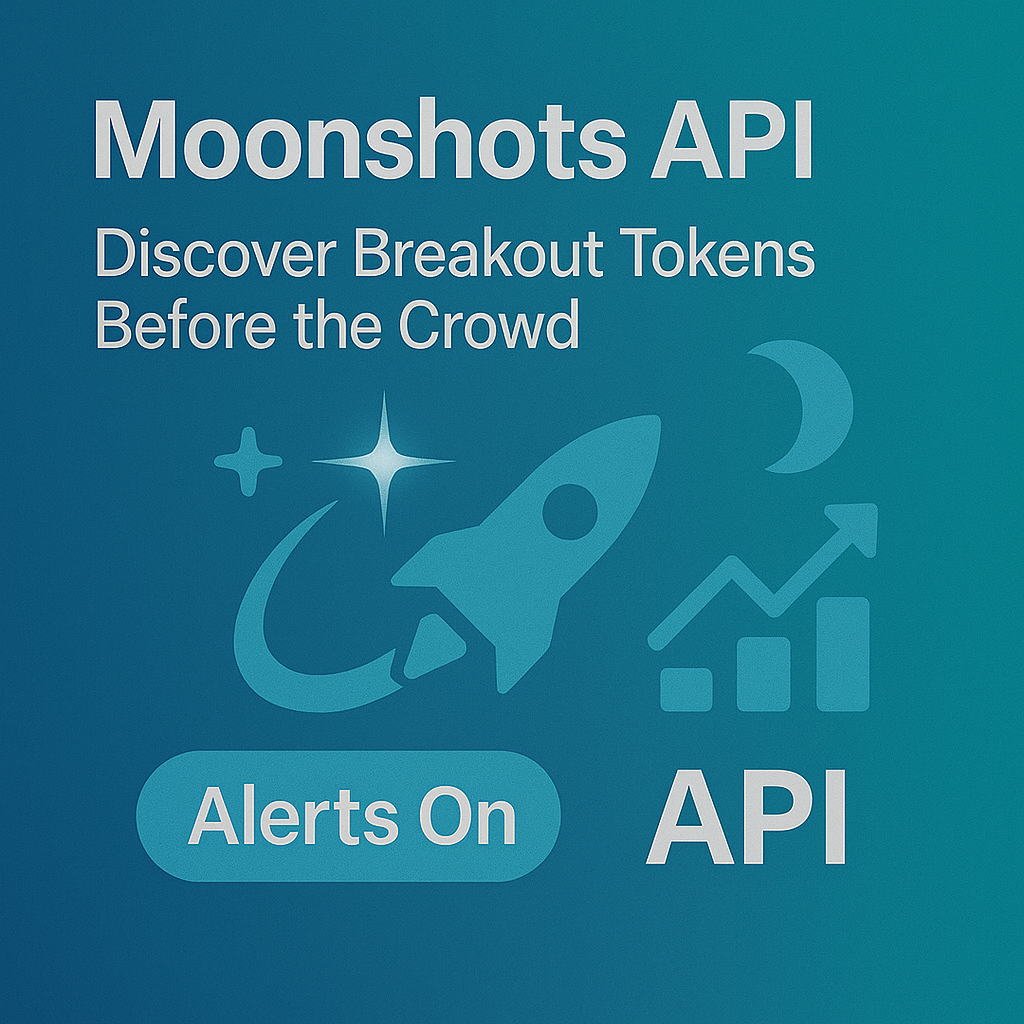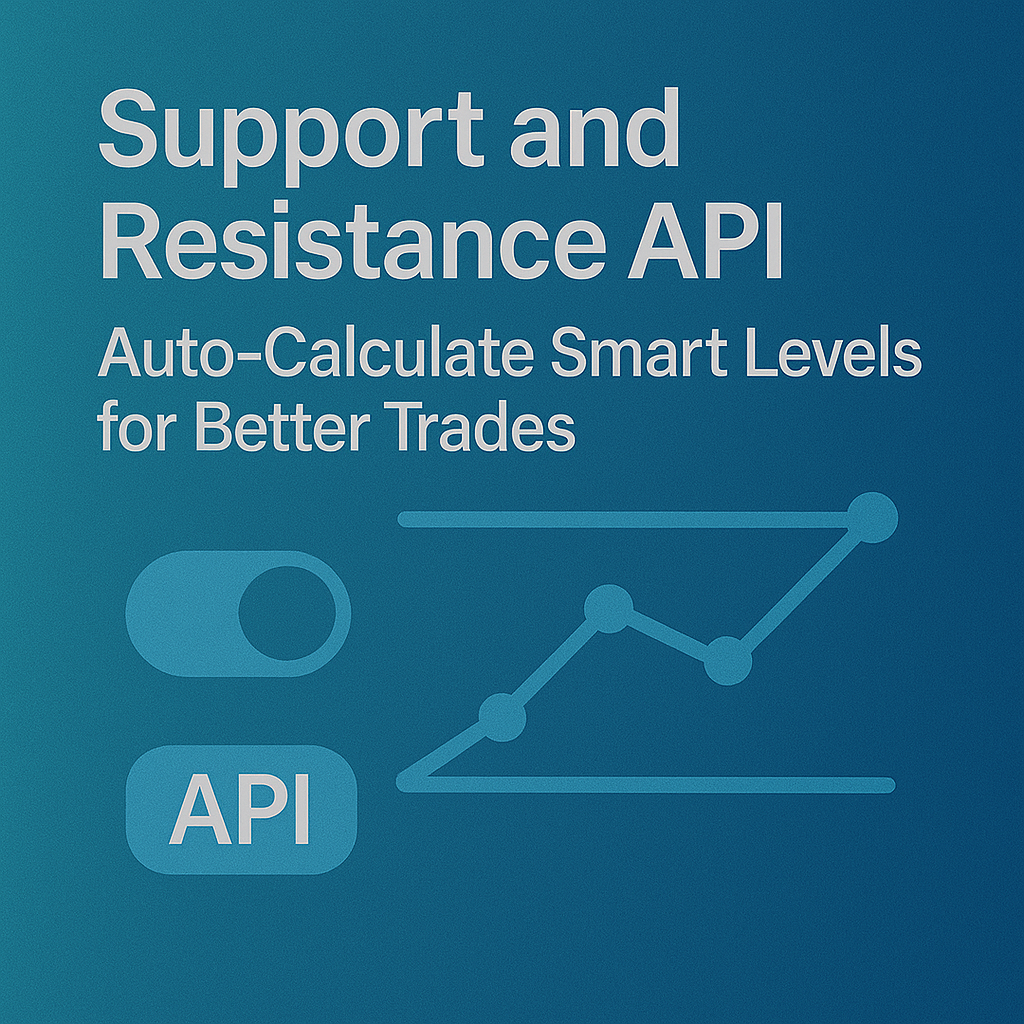Top Crypto Trading Platforms in 2025







%201.svg)
%201.svg)
Big news: We’re cranking up the heat on AI-driven crypto analytics with the launch of the Token Metrics API and our official SDK (Software Development Kit). This isn’t just an upgrade – it's a quantum leap, giving traders, hedge funds, developers, and institutions direct access to cutting-edge market intelligence, trading signals, and predictive analytics.
Crypto markets move fast, and having real-time, AI-powered insights can be the difference between catching the next big trend or getting left behind. Until now, traders and quants have been wrestling with scattered data, delayed reporting, and a lack of truly predictive analytics. Not anymore.
The Token Metrics API delivers 32+ high-performance endpoints packed with powerful AI-driven insights right into your lap, including:
Getting started with the Token Metrics API is simple:
At Token Metrics, we believe data should be decentralized, predictive, and actionable.
The Token Metrics API & SDK bring next-gen AI-powered crypto intelligence to anyone looking to trade smarter, build better, and stay ahead of the curve. With our official SDK, developers can plug these insights into their own trading bots, dashboards, and research tools – no need to reinvent the wheel.
%201.svg)
%201.svg)
The biggest gains in crypto rarely come from the majors. They come from Moonshots—fast-moving tokens with breakout potential. The Moonshots API surfaces these candidates programmatically so you can rank, alert, and act inside your product. In this guide, you’ll call /v2/moonshots, display a high-signal list with TM Grade and Bullish tags, and wire it into bots, dashboards, or screeners in minutes. Start by grabbing your key at Get API Key, then Run Hello-TM and Clone a Template to ship fast.
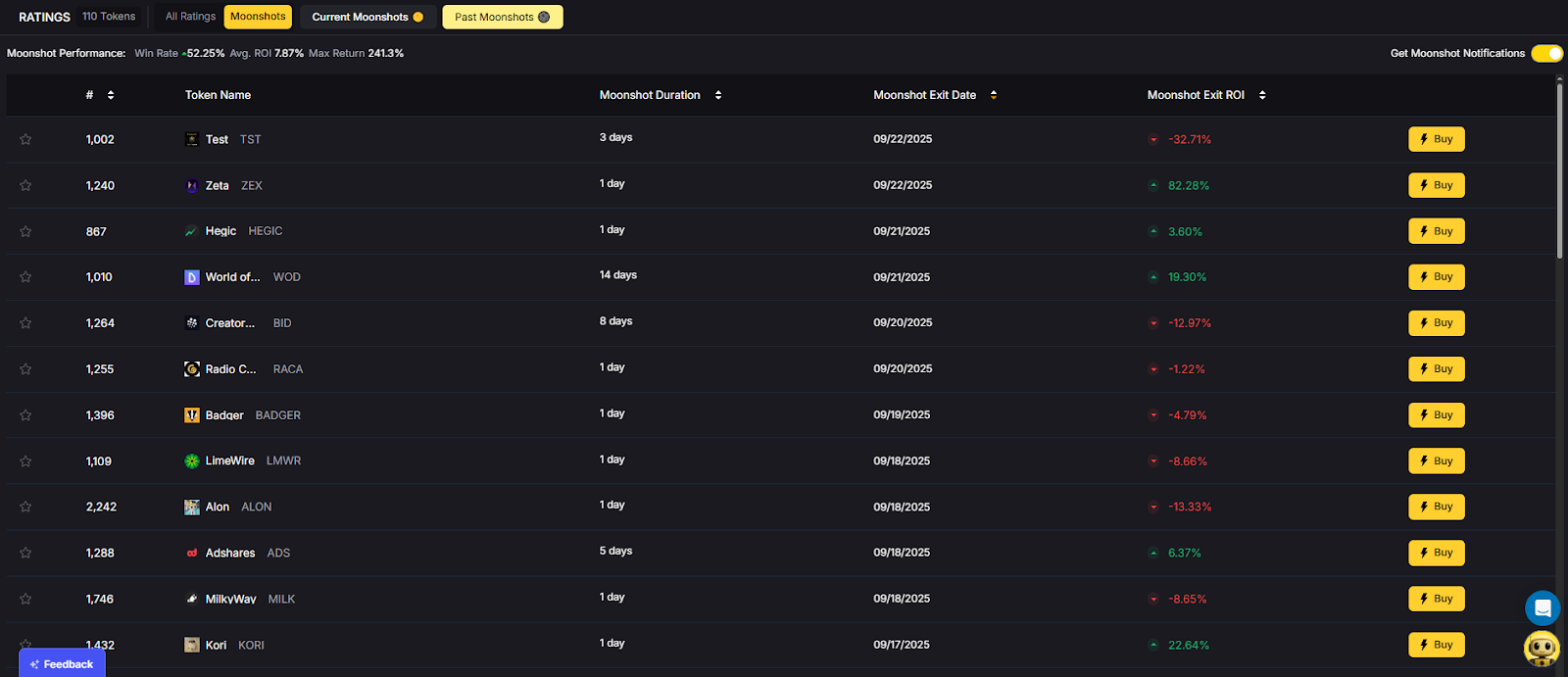
Discovery that converts. Users want more than price tickers—they want a curated, explainable list of high-potential tokens. The moonshots API encapsulates multiple signals into a short list designed for exploration, alerts, and watchlists you can monetize.
Built for builders. The endpoint returns a consistent schema with grade, signal, and context so you can immediately sort, badge, and trigger workflows. With predictable latency and clear filters, you can scale to dashboards, mobile apps, and headless bots without reinventing the discovery pipeline.
The Moonshots API cURL request is right there in the top right of the API Reference. Grab it and start tapping into the potential!
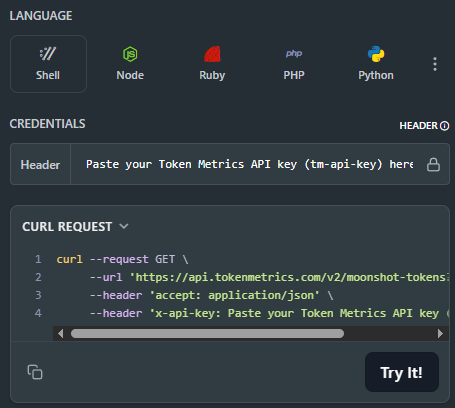
👉 Keep momentum: Get API Key • Run Hello-TM • Clone a Template
Fork a screener or alerting template, plug your key, and deploy. Validate your environment with Hello-TM. When you scale users or need higher limits, compare API plans.
The Moonshots endpoint aggregates a set of evidence—often combining TM Grade, signal state, and momentum/volume context—into a shortlist of breakout candidates. Each row includes a symbol, grade, signal, and timestamp, plus optional reason tags for transparency.
For UX, a common pattern is: headline list → token detail where you render TM Grade (quality), Trading Signals (timing), Support/Resistance (risk placement), Quantmetrics (risk-adjusted performance), and Price Prediction scenarios. This lets users understand why a token was flagged and how to act with risk controls.
Polling vs webhooks. Dashboards typically poll with short-TTL caching. Alerting flows use scheduled jobs or webhooks (where available) to smooth traffic and avoid duplicates. Always make notifications idempotent.
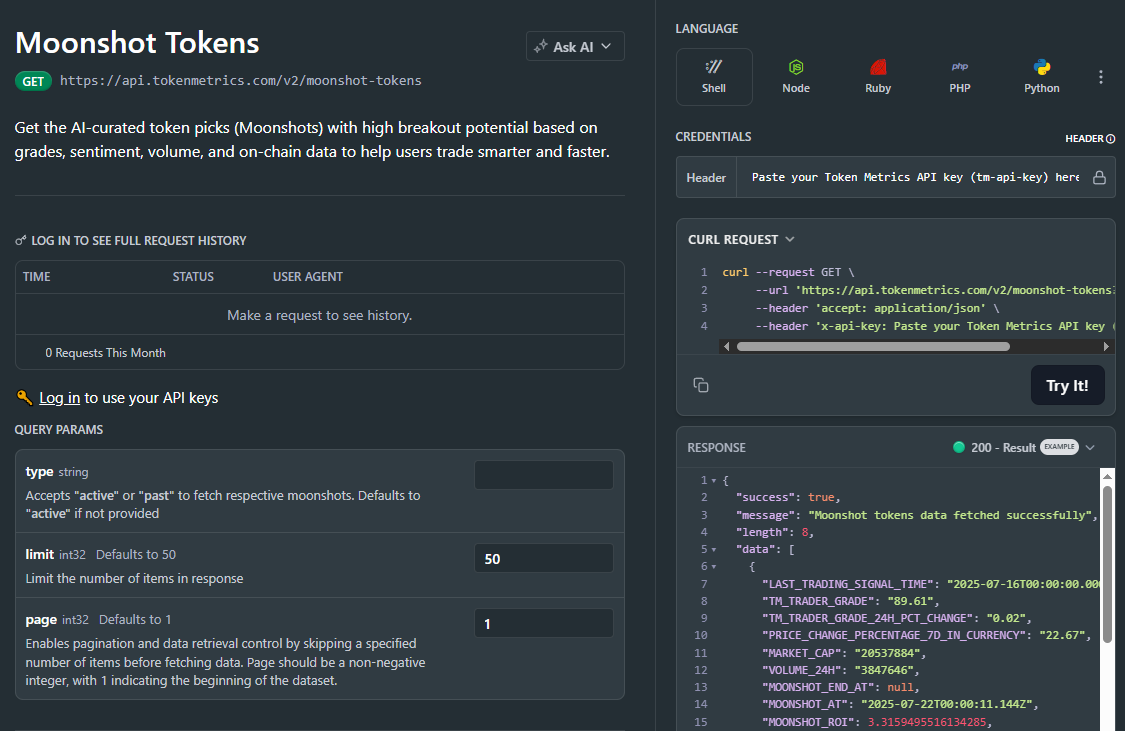
1) What does the Moonshots API return?
A list of breakout candidates with fields such as symbol, tm_grade, signal (often Bullish/Bearish), optional reason tags, and updated_at. Use it to drive discover tabs, alerts, and watchlists.
2) How fresh is the list? What about latency/SLOs?
The endpoint targets predictable latency and timely updates for dashboards and alerts. Use short-TTL caching and queued jobs/webhooks to avoid bursty polling.
3) How do I use Moonshots in a trading workflow?
Common stack: Moonshots for discovery, Trading Signals for timing, Support/Resistance for SL/TP, Quantmetrics for sizing, and Price Prediction for scenario context. Always backtest and paper-trade first.
4) I saw results like “+241%” and a “7.5% average return.” Are these guaranteed?
No. Any historical results are illustrative and not guarantees of future performance. Markets are risky; use risk management and testing.
5) Can I filter the Moonshots list?
Yes—pass parameters like min_grade, signal, and limit (as supported) to tailor to your audience and keep pages fast.
6) Do you provide SDKs or examples?
REST works with JavaScript and Python snippets above. Docs include quickstarts, Postman collections, and templates—start with Run Hello-TM.
7) Pricing, limits, and enterprise SLAs?
Begin free and scale up. See API plans for rate limits and enterprise options.
%201.svg)
%201.svg)
Most traders still draw lines by hand in TradingView. The support and resistance API from Token Metrics auto-calculates clean support and resistance levels from one request, so your dashboard, bot, or alerts can react instantly. In minutes, you’ll call /v2/resistance-support, render actionable levels for any token, and wire them into stops, targets, or notifications. Start by grabbing your key on Get API Key, then Run Hello-TM and Clone a Template to ship a production-ready feature fast.
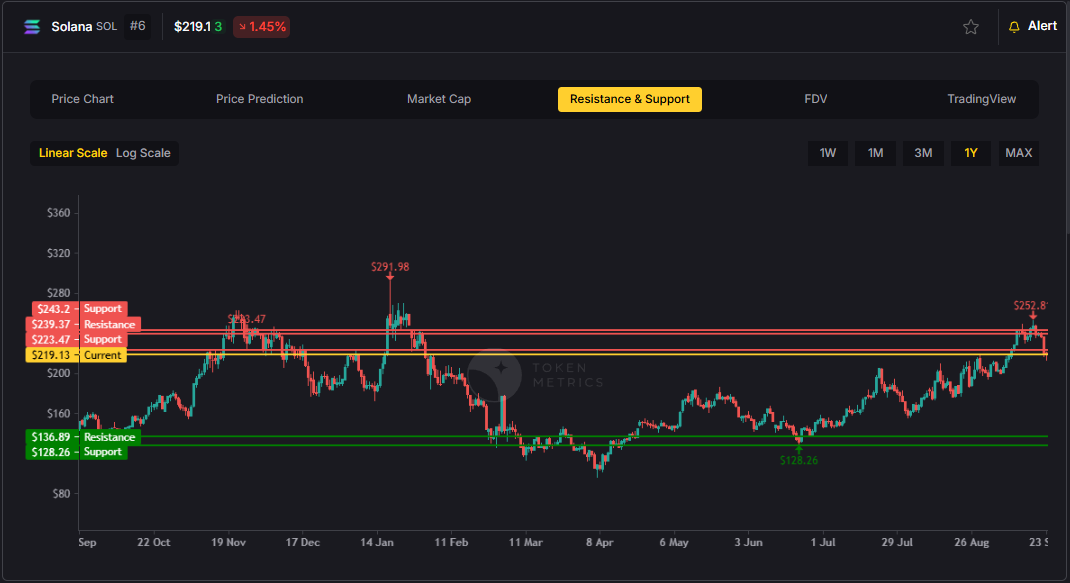
Precision beats guesswork. Hand-drawn lines are subjective and slow. The support and resistance API standardizes levels across assets and timeframes, enabling deterministic stops and take-profits your users (and bots) can trust.
Production-ready by design. A simple REST shape, predictable latency, and clear semantics let you add levels to token pages, automate SL/TP alerts, and build rule-based execution with minimal glue code.
Need the Support and Resistance data? The cURL request for it is in the top right of the API Reference for quick access.
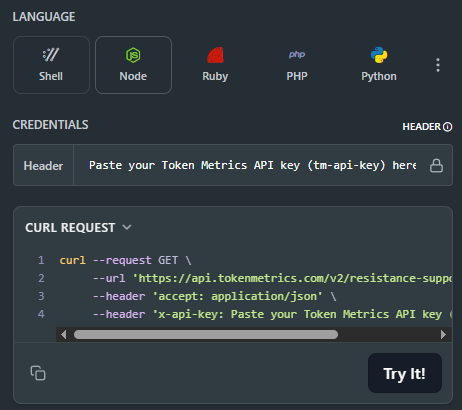
👉 Keep momentum: Get API Key • Run Hello-TM • Clone a Template
Kick off with our quickstarts—fork a bot or dashboard template, plug your key, and deploy. Confirm your environment by Running Hello-TM. When you’re scaling or need webhooks/limits, review API plans.
The Support/Resistance endpoint analyzes recent price structure to produce discrete levels above and below current price, along with strength indicators you can use for priority and styling. Query /v2/resistance-support?symbol=<ASSET>&timeframe=<HORIZON> to receive arrays of level objects and timestamps.
Polling vs webhooks. For dashboards, short-TTL caching and batched fetches keep pages snappy. For bots and alerts, use queued jobs or webhooks (where applicable) to avoid noisy, bursty polling—especially around market opens and major events.
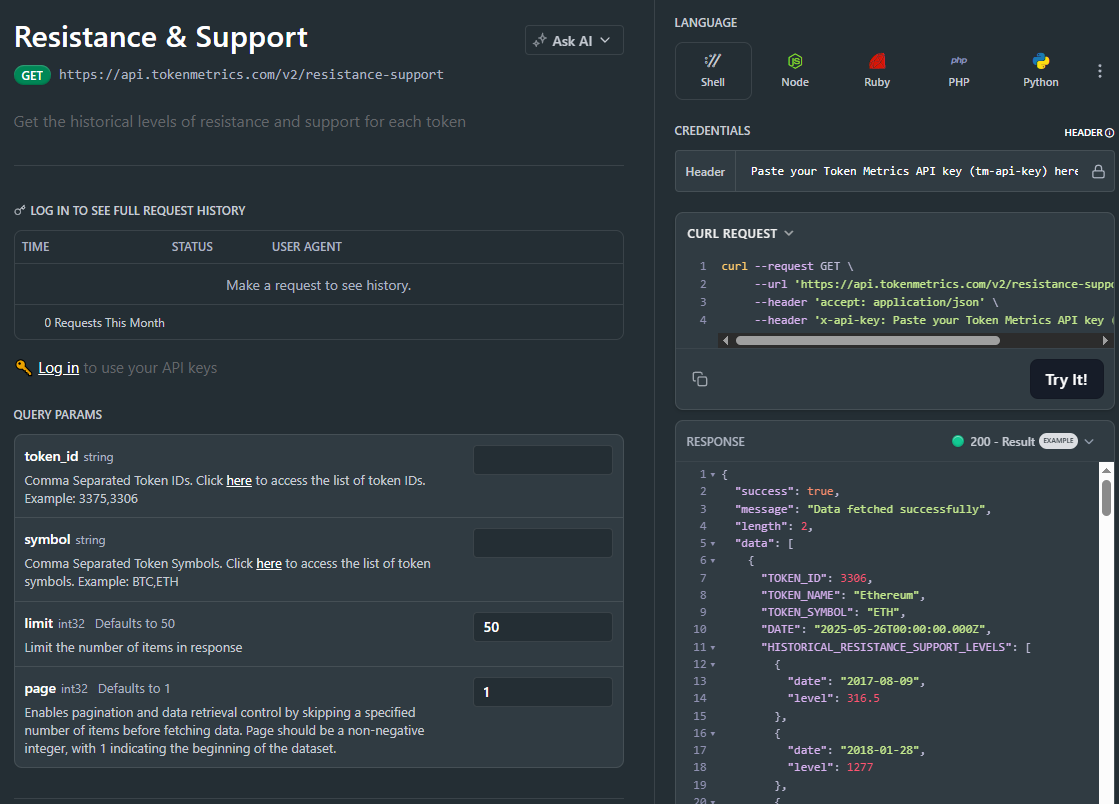
1) What does the Support & Resistance API return?
A JSON payload with arrays of support and resistance levels for a symbol (and optional timeframe), each with a price and strength indicator, plus an update timestamp.
2) How timely are the levels? What are the latency/SLOs?
The endpoint targets predictable latency suitable for dashboards and alerts. Use short-TTL caching for UIs, and queued jobs or webhooks for alerting to smooth traffic.
3) How do I trigger alerts or trades from levels?
Common patterns: alert when price is within X% of a level, touches a level, or breaks beyond with confirmation. Always make downstream actions idempotent and respect rate limits.
4) Can I combine levels with other endpoints?
Yes—pair with /v2/trading-signals for timing, /v2/tm-grade for quality context, and /v2/quantmetrics for risk sizing. This yields a complete decide-plan-execute loop.
5) Which timeframe should I use?
Intraday bots prefer shorter horizons; swing/position dashboards use daily or higher-timeframe levels. Offer a timeframe toggle and cache results per setting.
6) Do you provide SDKs or examples?
Use the REST snippets above (JS/Python). The docs include quickstarts, Postman collections, and templates—start with Run Hello-TM.
7) Pricing, limits, and enterprise SLAs?
Begin free and scale as you grow. See API plans for rate limits and enterprise SLA options.
%201.svg)
%201.svg)
Most traders see price—quants see probabilities. The Quantmetrics API turns raw performance into risk-adjusted stats like Sharpe, Sortino, volatility, drawdown, and CAGR so you can compare tokens objectively and build smarter bots and dashboards. In minutes, you’ll query /v2/quantmetrics, render a clear performance snapshot, and ship a feature that customers trust. Start by grabbing your key at Get API Key, Run Hello-TM to verify your first call, then Clone a Template to go live fast.
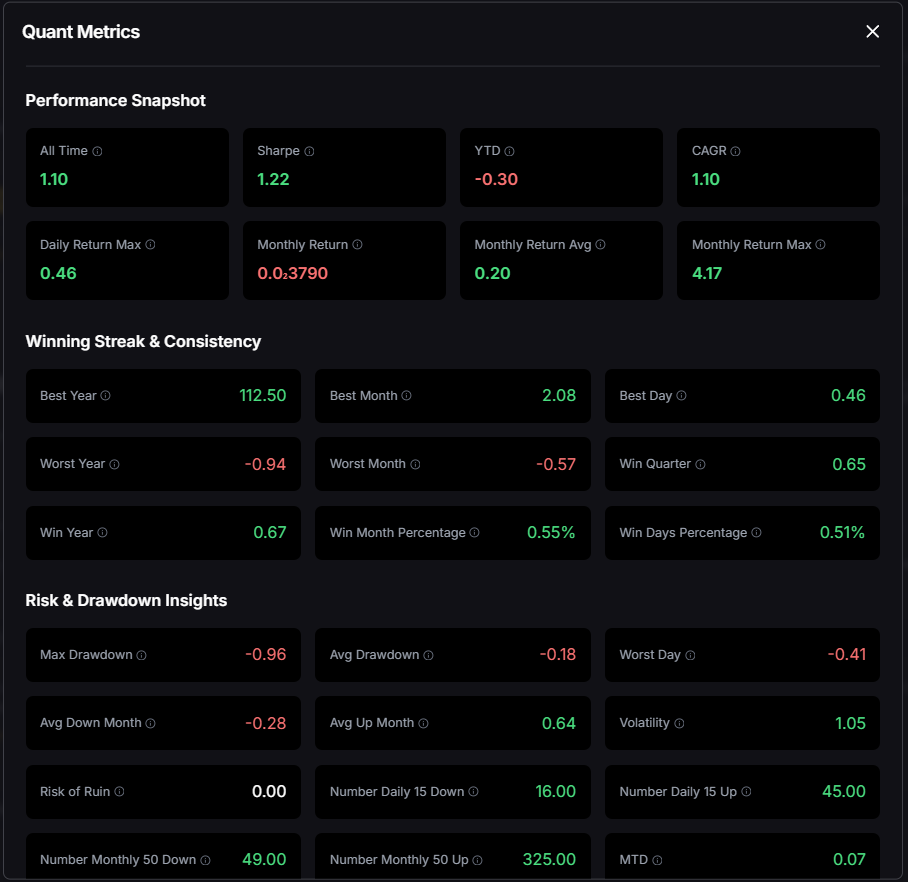
Risk-adjusted truth beats hype. Price alone hides tail risk and whipsaws. Quantmetrics compresses edge, risk, and consistency into metrics that travel across assets and timeframes—so you can rank universes, size positions, and communicate performance like a pro.
Built for dev speed. A clean REST schema, predictable latency, and easy auth mean you can plug Sharpe/Sortino into bots, dashboards, and screeners without maintaining your own analytics pipeline. Pair with caching and batching to serve fast pages at scale.
The Quant Metrics cURL request is located in the top right of the API Reference, allowing you to easily integrate it with your application.
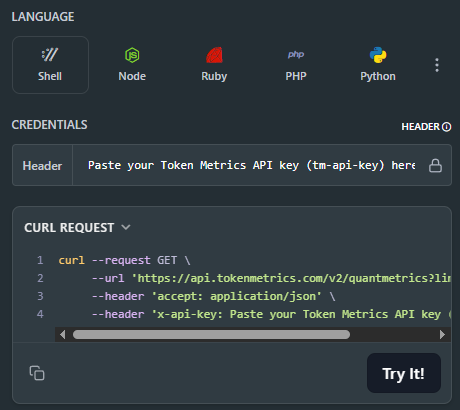
👉 Keep momentum: Get API Key • Run Hello-TM • Clone a Template
Kick off from quickstarts in the docs—fork a dashboard or screener template, plug your key, and deploy in minutes. Validate your environment with Run Hello-TM; when you need more throughput or webhooks, compare API plans.
Quantmetrics computes risk-adjusted performance over a chosen lookback (e.g., 30d, 90d, 1y). You’ll receive a JSON snapshot with core statistics:
Call /v2/quantmetrics?symbol=<ASSET>&window=<LOOKBACK> to fetch the current snapshot. For dashboards spanning many tokens, batch symbols and apply short-TTL caching. If you generate alerts (e.g., “Sharpe crossed 1.5”), run a scheduled job and queue notifications to avoid bursty polling.
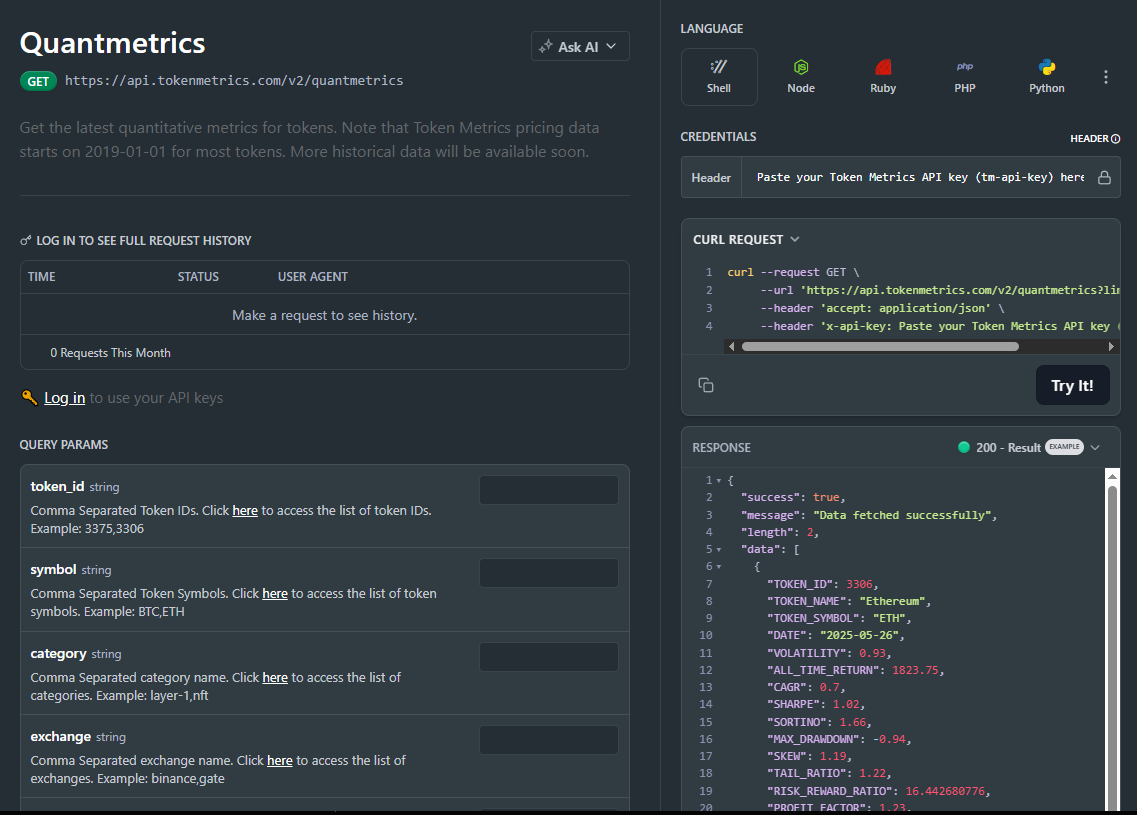
1) What does the Quantmetrics API return?
A JSON snapshot of risk-adjusted metrics (e.g., Sharpe, Sortino, volatility, max drawdown, CAGR) for a symbol and lookback window—ideal for ranking, sizing, and dashboards.
2) How fresh are the stats? What about latency/SLOs?
Responses are engineered for predictable latency. For heavy UI usage, add short-TTL caching and batch requests; for alerts, use scheduled jobs or webhooks where available.
3) Can I use Quantmetrics to size positions in a live bot?
Yes—many quants size inversely to volatility or require Sharpe ≥ X to trade. Always backtest and paper-trade before going live; past results are illustrative, not guarantees.
4) Which lookback window should I choose?
Short windows (30–90d) adapt faster but are noisier; longer windows (6–12m) are steadier but slower to react. Offer users a toggle and cache each window.
5) Do you provide SDKs or examples?
REST is straightforward (JS/Python above). Docs include quickstarts, Postman collections, and templates—start with Run Hello-TM.
6) Polling vs webhooks for quant alerts?
Dashboards usually use cached polling. For threshold alerts (e.g., Sharpe crosses 1.0), run scheduled jobs and queue notifications to keep usage smooth and idempotent.
7) Pricing, limits, and enterprise SLAs?
Begin free and scale up. See API plans for rate limits and enterprise SLA options.

%201.svg)
%201.svg)
3D NFTs, or Non-Fungible Tokens, are the latest trend in digital asset ownership. They are a form of digital asset that is unique, completely non-fungible, and immutable, allowing anyone to securely own and trade digital assets in a brand new way.
3D NFTs are created using 3D modeling tools such as Blender and 3D Studio Max, and stored on the blockchain, making them secure, transparent, and immutable. It’s now possible to own and trade digital assets in a new way. This article will take a closer look at what 3D NFTs are, how they work, and how you can use them to your advantage.
In order to own a 3D NFT, you will need a digital wallet that supports the creation and trade of 3D NFTs. These wallets will store your 3D NFTs, making them easy to trade with others and view your ownership rights in the blockchain. If you want to trade your 3D NFTs, you can easily do so by sending your 3D NFTs from your wallet to the wallet of the individual you want to trade with.
3D NFTs are different than other digital assets in that they are completely non-fungible. This means that each 3D NFT is completely one of a kind, making each one completely different from the next. Because each 3D NFT is one of a kind, each one will have its own value that can fluctuate depending on the demand for that 3D NFT.
There are many benefits to using 3D NFTs over other digital assets. First and foremost, each 3D NFT is completely one of a kind, making them completely unique and interesting. This makes them much more exciting to collect, trade, and own. Since each 3D NFT is completely one of a kind and can be anything, they are much more interesting to own than other digital assets.
3D NFTs are also secure, transparent, and immutable, meaning that they can’t be hacked, all ownership rights can be seen by anyone, and they can’t be changed or manipulated in any way. Finally, they are also easy to create and trade, meaning anyone can start collecting and trading these digital assets.
To create a 3D NFT, you need to follow these steps:
There are various places where you can purchase and sell 3D NFTs, making them easy to trade with others. You can purchase 3D NFTs from online 3D asset marketplaces, such as Rarible, which allow you to purchase and sell unique 3D NFTs.
You can also use other known marketplaces, such as OpenSea or Magic Eden, to easily purchase and sell 3D NFTs.
You will need to store your 3D NFTs in a digital wallet that supports 3D NFTs. Several different wallets support 3D NFTs; many even have mobile apps that make it easy to trade and collect your 3D NFTs.
If you want to use 3D NFTs in your business, they can be a great way to engage with your customers.
You can create your own 3D NFTs to give to customers, allowing them to trade and show off their digital assets.
You can also sell unique 3D NFTs, allowing customers to own rare, one-of-a-kind assets.
You can also use 3D NFTs as a loyalty reward, giving your customers a unique digital asset to show their loyalty to your brand.
The possibilities are endless. Reddit is a good example of this.
There are various types of 3D NFTs you can collect and trade. You can collect unique video game characters, unique pieces of art, limited-edition sneakers, or even use 3D NFTs for marketing campaigns.
No matter what type of 3D NFT you collect, they will all be completely one of a kind, making them much more interesting to collect and trade than traditional digital assets. Also, 3D NFT projects are numerous and range from digital art to virtual real estate.
Some of the most popular 3D NFT projects include:
There are very few legal implications to collecting and trading 3D NFTs. While you should always research to ensure you follow all applicable laws, most of these laws focus on trading and selling 3D NFTs rather than collecting and owning them.
In conclusion, 3D NFTs are a new and exciting development in the world of digital assets, providing a way to prove ownership and authenticity of 3D models and monetize digital art, games, and virtual assets. With the potential for limitless applications, 3D NFTs are poised to revolutionize the way we think about and trade digital assets.

%201.svg)
%201.svg)
Ethereum and Ethereum Classic are two of the most popular cryptocurrencies in the world today. Both of these digital currencies have exploded in value over the past few years and have become some of the most sought-after investments in the crypto market.
But what is the key difference between ETH and ETC?
Ethereum (ETH) and Ethereum Classic (ETC) are both blockchain networks, but they have a few key differences that make them unique. Ethereum is a newer platform that is designed to be more scalable and secure than Ethereum Classic. Ethereum Classic, on the other hand, is an open source blockchain network that has a focus on decentralization, immutability, and censorship resistance. In this article, we'll compare the two networks and explain why Ethereum is the better choice for most investors.
Ethereum (ETH) is a decentralized blockchain network that runs smart contracts and enables the development of decentralized applications (dApps). Ethereum was created by Vitalik Buterin and officially released in 2015.
Ethereum Classic (ETC) is an extension (not a clone) of the original Ethereum, which was forked away by the Ethereum Foundation by launching a new protocol just an year later in 2016.
To be precise, Ethereum Classic was created when the original Ethereum network and currency were split following the DAO hack in 2016. Ethereum and Ethereum Classic are both open source networks that are maintained by their respective development teams. Unlike Bitcoin, both Ethereum and Ethereum Classic use a Proof-of-Work consensus algorithm. Both these networks also use a native digital token to fuel their networks.
As Ether is the native token of the Ethereum network, you can use it to pay for transaction or computational services on the Ethereum network. Similarly, ETC tokens are used by participants on the Ethereum Classic network.
But, the majority of the crypto crowd still needs a clean chit over the key differences that make them absolutely distinct.
So, let’s get into it.
Scalability - Ethereum (ETH) and Ethereum Classic (ETC) are both open-source blockchain networks that allow you to build decentralized applications. However, Ethereum has been designed to be more scalable. That means the network can handle more transactions at a higher speed, making it a better choice for everyday applications.
Security - While both Ethereum and Ethereum Classic are secure blockchain networks, Ethereum is more scalable and has a better security track record. Ethereum Classic has been dealing with network security issues since its inception.
Decentralization - Decentralization is one of the core values offered by blockchain networks like Ethereum and Ethereum Classic. Decentralization on the Ethereum network is slightly better than Ethereum Classic, but both networks have a long way to go before they can be considered decentralized.
Immutability - Immutability is another core value offered by blockchain networks. However, the Ethereum and Ethereum Classic networks are still very far from achieving full immutability. Both networks have suffered from various instances of data manipulation.
Censorship resistance - Censorship resistance is another core value offered by blockchain networks. However, both Ethereum and Ethereum Classic are far from achieving full censorship resistance. Both networks can be subjected to censorship by governments and other centralized entities.
While both Ethereum and Ethereum Classic are great investments, we believe Ethereum is the better choice for most investors for a few reasons. First, Ethereum is more decentralized. Second, Ethereum has been around longer than Ethereum Classic. This means the network is more scalable, secure, and well-established than its competitor. Finally, Ethereum has a wider range of applications than Ethereum Classic.
Overall, Ethereum is the better blockchain network when compared to Ethereum Classic.
Ethereum and Ethereum Classic, both of these networks have exploded in value over the past few years and have become some of the most sought-after investments in the crypto market.
When the DAO got hacked and lost $50 million, Ethereum needed a solid technology to replace the old one. So, a hard fork was done. But many traditional supporters of Ethereum did not want to go with the hard fork, and they stayed with the old blockchain technology. As a result, Ethereum Classic was born.
Disclaimer: The information provided on this website does not constitute investment advice, financial advice, trading advice, or any other sort of advice and you should not treat any of the website's content as such.
Token Metrics does not recommend that any cryptocurrency should be bought, sold, or held by you. Do conduct your own due diligence and consult your financial advisor before making any investment decisions.

%201.svg)
%201.svg)
Trading indicators are a crucial aspect of the investing world, and in the volatile world of cryptocurrency, it becomes all the more important to have them on your side.
TradingView, the leading social trading platform, provides traders with the tools they need to make informed decisions and take their trading game to the next level.
Among the tools offered by TradingView is the Token Metrics Indicator, a powerful tool that combines multiple technical analysis indicators to provide Long/Short signals for crypto assets.
In this blog, we will dive into the Token Metrics TradingView Indicator and how it can help you to improve your trading strategy.
Whether you are a seasoned trader or just starting out, the Token Metrics TradingView Indicator can help you make informed investment decisions and potentially avoid costly mistakes.
That said, let’s get started.
The Token Metrics TradingView Indicator is a powerful tool for crypto assets on TradingView, combining multiple strategies to give you clear Long and Short signals for your trades.
It gives you a clear picture of the market with four key components: Clouds, Trend Line, Signals, and Channels. The Clouds show the current trend (green for bullish and red for bearish), the Trend Line provides a long-term market outlook with resistance and support levels, the Signals provide buy/sell signals and the Channels help to determine the previous swing high and low to get an idea of where resistance/support might be forming and where breakouts can occur.

The backtesting feature allows users to assess the strategy's historical performance and understand its potential, risk profile, and suitability for different market conditions.

The Token Metrics TradingView Indicator offers customization options to match individual trading preferences through its inputs.
Users can adjust these values based on risk tolerance and market conditions, allowing optimal performance and profitability. Whether you prefer a fast-reacting or slow-adapting strategy, the Token Metrics TradingView Indicator has you covered.
The Token Metrics Trading View Indicator offers traders two distinct approaches to cryptocurrency trading: long-term and high-frequency trading. Each style has its considerations and best practices to maximize profitability.
For long-term traders, the Token Metrics TradingView Indicator provides a trend-following strategy best suited for Daily and Weekly timeframes. This approach excels in trending markets but may produce false signals in choppy or range-bound markets. It is important for long-term traders to keep in mind that the goal is to gain exposure to strong trends without excessive trading.
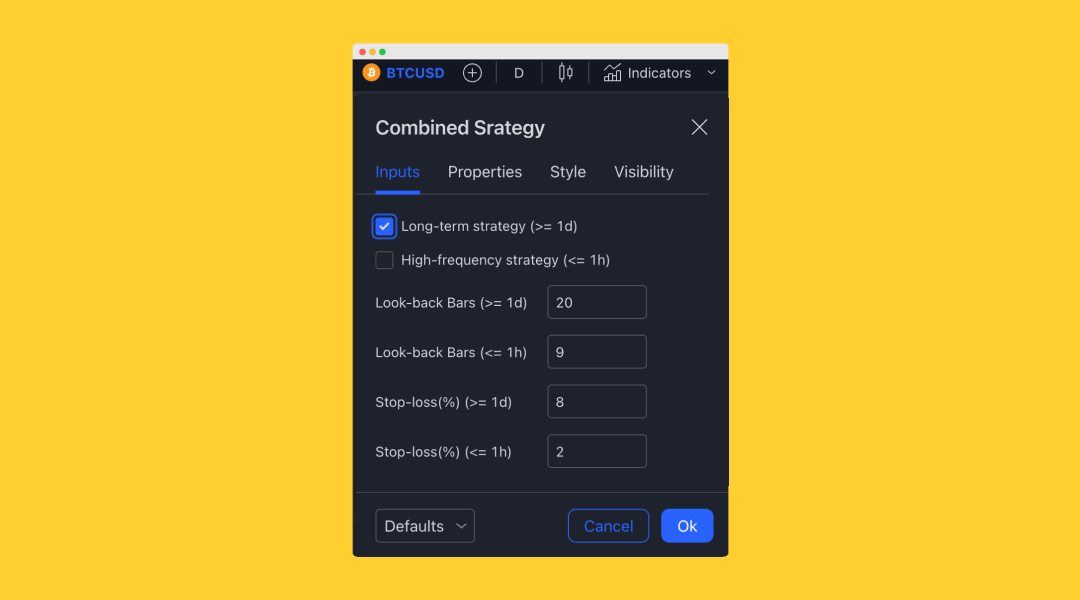
On the other hand, high-frequency traders can take advantage of the mean-reverting capabilities of the Token Metrics TradingView Indicator. This approach is best suited for 15min, 30min, and 1hr timeframes and works best in choppy and range-bound markets. Mean-reversion is stronger on low time frame charts, making this strategy ideal for traders looking to buy at the bottom of the channel and sell at the top. It is important for high-frequency traders to remember that this strategy is not intended for exposure to prevailing trends.

Whether you prefer long-term or high-frequency trading, the Token Metrics TradingView Indicator provides the tools and customization options to match your individual style. By understanding the strengths and limitations of each approach, you can make the most out of your trading strategy with the Token Metrics TradingView Indicator.
The Token Metrics TradingView Indicator is included in all Token Metrics Plans.
You can also get this indicator as a standalone product by visiting this page to learn more.
In conclusion, the Token Metrics TradingView Indicator is a versatile tool that can be customized to fit the needs of both long-term and high-frequency traders.
Whether you're looking to gain exposure to strong trends or to take advantage of mean-reversion in choppy markets, the Token Metrics TradingView Indicator provides the features and flexibility you need to achieve your trading goals.
With its comprehensive backtesting capabilities, you can get a deep understanding of the performance of your strategy, allowing you to make informed decisions and achieve consistent profits in the cryptocurrency market.

%201.svg)
%201.svg)
In this guide, we will answer what crypto yield farming is and how to do it.
Yield farming is a revolutionary way of earning passive income through cryptocurrency investments. It is a relatively new concept and has gained much attention in the crypto world. Yield farming involves using your cryptocurrency assets and taking advantage of lending platforms, decentralized finance protocols, and staking pools to generate incentives for interest payments, rewards, and capital gains.
In this descriptive guide to crypto yield farming, you'll learn about the different types of yield farming, the rewards available, and the associated risks. You can earn passive income through yield farming with the right strategies and knowledge. So, let's dive right in and learn about crypto yield farming.
Yield farming is a process of using your cryptocurrency assets to generate incentives in the form of:
In other words, it is a form of passive income from cryptocurrency assets. Yield farming can also be considered a strategic investment strategy that allows you to earn income from your idle assets by lending them to other users. This process is similar to how people earn income from their savings accounts.
These idle assets that you can stake can be your:
But how is this beneficial to you?
Yield farming offers a wide range of benefits for both individuals and businesses.
So, what do you need to do to get started with yield farming?
To begin with, the yield farmers will need to deposit their coins or tokens into decentralized applications or dApps of their choice for the following:
A few examples of dApps include crypto wallets, DEXs, decentralized social media, and more. Since these investors enhance the liquidity in their chosen dApp, they're referred to as liquidity providers. The crypto that yields farmers' deposits into DeFi protocols gets locked into autonomous smart contracts.
There are three types of yield farming - lending, providing liquidity, and staking.
Lending refers to lending your idle cryptocurrency assets to earn interest payments. You are generating revenue through interest payments when you lend your cryptocurrency assets. This process is similar to how people earn interest from their savings accounts.
Providing liquidity to decentralized apps for traders to trade on can also generate you fees. However, keep in mind that there exists impermanent loss in the process.
Staking refers to lending your coins to earn rewards through coins and staking fees. You are generating revenue through rewards and staking fees when you stake your coins. Rewards can come in the form of coins, tokens, or other types of digital assets. You are lending your coins to earn rewards.
Rewards are the incentives earned when you lend idle coins and cryptocurrencies to earn interest payments and generate passive income. There are many different rewards available to those who participate in yield farming. Some include interest payments, votes, staking rewards, and airdrops.
Interest payments: This is the primary reward generated by yield farming. Interest payments are generated when you lend idle coins and cryptocurrencies to other participants.
Votes: This refers to the ability to vote on certain network issues.
Staking rewards are rewards generated by staking crypto assets for a certain period.
Airdrops: This refers to the free crypto coins and tokens resulting from participating in a certain network or blockchain project.
Now that you know the benefits of yield farming, it's also important to know the risks. This is because no investment is risk-free, and the same is true for yield farming. When you decide to earn income from yield farming, you must consider the risks associated with it. Some risks associated with yield farming include network, liquidity, counterparty, and regulatory risks.
Network risk refers to the risk associated with the security of the network/blockchain and its ability to function as expected.
Liquidity risk is associated with the ability to liquidate your assets when you need them.
Counterparty risk refers to the risk associated with the ability of the person/entity with whom you have the contract to fulfill the obligations.
Regulatory risk is the risk associated with the ability of the government to enact new laws that can affect your earnings.
Smart contract risk is the risk associated with the probability of smart contracts getting hacked due to a bug or backdoor.
That said, there are definitely risks involved that you need to be aware of.
There are many strategies you can use for yield farming. Some of them include lending your idle assets to earn interest payments, staking your coins to earn rewards, and using different DAFs to generate passive income.
Lending your idle assets: This is one of the most common ways to earn income through yield farming. You can use your idle assets, such as your computer's processing power, to lend them to others who need them.
Staking your coins: This is another popular way to generate passive income through yield farming. You can lend your coins to earn rewards.
Using different DAFs: This refers to the use of decentralized autonomous funds that can generate passive income.
Yield farming is a dynamic space that tends to change quickly; it often requires vigilance and time for farmers to cull out the best possible strategies. However, for someone who can manage it, yield farming will be highly profitable in 2023, even in the bearish market.
That said, yield farming is significantly risky with rug pulls, hacks, impermanent loss, etc.
So, choosing your battle is important before getting into the ring.
Many different types of yield farming platforms are available for you to use.
You can use these platforms to take advantage of your idle assets to generate income through interest payments and rewards.
Some popular yield farming platforms include Yearn Finance, Lido, and Liquity.
Yield farming is a revolutionary way of earning passive income through cryptocurrency investments. It involves using your cryptocurrency assets to take advantage of lending platforms, decentralized finance protocols, and staking pools to generate incentives in interest payments, rewards, and capital gains. While lucrative, it can be a riskier investment depending on the platform you go for and the type of yield you are generating.

%201.svg)
%201.svg)
Cryptocurrencies have quickly become an important part of the global financial system, allowing users to make secure, low-cost transactions without needing a bank or other financial institution. One of the most popular and well-known cryptocurrencies is XRP (Ripple), a digital asset designed specifically for payments, remittances, and other forms of financial transactions.
In this beginner’s guide to XRP, we'll look at how this cryptocurrency works, its benefits, and how it differs from other digital assets. We'll also discuss the process for buying and selling XRP and some potential issues that users need to be aware of. Whether you're new to cryptocurrency or just looking to learn more about XRP, this guide should provide a comprehensive overview of this digital asset and its potential uses.
XRP/Ripple is a blockchain network and digital token created to facilitate low-cost, secure, and fast international payments. Unlike other cryptocurrencies, XRP was designed from the beginning to be used for these financial transactions instead of a more general purpose like Bitcoin, Ethereum, and Litecoin.
XRP can transfer money across borders quickly and with extremely low fees, making it ideal for banks, payment providers, and other financial institutions. XRP can complete these transfers quickly due to its use of a consensus protocol that allows it to confirm transactions within just 4 seconds.
The XRP token is used to pay network fees for these transfers and is also used by financial service providers as a source of liquidity for cross-border payments. However, the XRP token is not required to use the Ripple network.
There are many benefits to using XRP, including:
These benefits make it an ideal choice for banks and other financial institutions that need to process international payments quickly and cheaply. Individuals can also use XRP to make international transfers, but they'll need to purchase the asset before doing so. XRP has advantages over other cryptocurrencies, including Bitcoin, as it was designed specifically for financial transactions.
"Ripple can process almost 1500 transactions per second, compared to Ethereum's 21 and Bitcoin's 7."
To send money from one person to another, the sender must create a transaction sent to the network and verify. This process also involves creating an "offer" where the sender specifies the amount of XRP and the network fee. Once completed, the sender's wallet submits the transaction to the network and the fee.
The network then forwards the transaction to one of the XRP "liquidity providers," who will purchase the amount of XRP specified by the sender and release it to the receiver of the transaction. These liquidity providers hold large amounts of XRP and sell it to other users. After the transaction has been verified by the network and the fee paid, the receiver will receive the money in his or her account.
Anyone with access to internet can purchase XRP and store it in a digital wallet. However, some exchanges require users to undergo a verification process before they can begin trading. In addition, most exchanges charge a small trading fee for each transaction, which can add up if you buy and sell frequently.
Once you've obtained XRP, you can store it in a digital wallet, allowing you to access it from anywhere and providing you with control over the private keys.
Various wallets are available for storing digital assets, including hardware and paper wallets.
Like all cryptocurrencies, XRP has potential network risk and governance issues. The community has debated these issues since XRP was first created, but they still need to be resolved.
XRP has a large network of validators that are responsible for verifying transactions. However, the network is centralized, which means it is vulnerable to a single point of failure. If the validators decide to act maliciously, they may be able to prevent other transactions from being verified or even reverse transactions that have already been approved.
XRP is different from most other cryptocurrencies because it was created specifically for financial transactions. This means that Ripple can process almost 1500 transactions per second, compared to Ethereum's 21 and Bitcoin's 7. XRP differs from other digital assets because it is not mined like other cryptocurrencies.
Ripple's token, XRP, became available in 2013 when the company conducted its first fundraising round. Following this initial coin offering (ICO), the price of XRP remained relatively low for several years, with the coin's price dropping below $0.01 in 2016.
However, XRP saw a significant spike in value in 2017, increasing by more than 36,000%. Since then, the price has fluctuated, but it has remained relatively high, and at the time of writing, the price of XRP stands at just under $0.50.
Unlike other cryptocurrencies, Ripple was not designed to be mined like Bitcoin and Ethereum. Ripple's creators created 100 billion XRP tokens at the start of the project and distributed them to investors.
However, new XRP tokens are added to the network every few months through a process known as "escrow," where the network creates enough tokens to provide liquidity to the global financial system.
Some of the best XRP wallets you can use to store your coins in include:
Now that you know what XRP is, you can simply create your account in any of the exchange platforms below, complete your KYC and instantly buy your XRP tokens.
Owing to the technical analysis of the XRP, it is expected to reach a minimum price of $0.54 and a maximum of $0.64. Hence, the average trading price at $0.56. Experts believe that this crypto asset has great potential in terms of growing in value.
Having said that, it is always suggested for you to do your own research before arriving at a decision.
Ripple aims to create a global network of financial institutions and payment providers that use XRP for cross-border payments. If this vision is achieved, Ripple's cryptocurrency could become one of the world's most widely used digital assets, with billons of dollars flowing through the network daily.
There are some challenges that Ripple will have to overcome to achieve this goal. For example, Ripple needs to expand its network to include more financial institutions while convincing them to use XRP instead of their existing payment networks.
Ripple has streamlined the process of global payment network while providing a useful service for existing financial institutions. Although there is also uncertainty about whether the XRP token should remain centralized or if it should be decentralized, it is one of the coins to keep an eye on.
The information provided on this website does not constitute investment/trading/financial advice and you should not treat any of the website’s content as such. Token Metrics does not recommend that any cryptocurrency should be bought, sold, or held by you.
Do conduct your own due diligence and consult your financial advisor before making any investment decisions. We only offer comprehensive information which may change over time.

%201.svg)
%201.svg)
Polkadot is an innovative, interoperable blockchain network that has the potential to revolutionize the crypto industry. It is the brainchild of Dr. Gavin Wood, one of the co-founders of Ethereum.
Polkadot provides a platform for different blockchains to interact with each other, enabling the exchange of data and assets between them.
With its scalability, robust security features, and cross-chain compatibility, Polkadot is quickly becoming one of the most popular networks for developers and users. This comprehensive guide will provide an overview of the Polkadot network and its features and a look at some of the projects built on the platform. From its scalability to its security and interoperability, this guide will cover the basics of Polkadot and why it is revolutionizing the blockchain industry.
The Polkadot network is a scalable, interoperable blockchain network designed to connect numerous blockchain networks and facilitate data and asset transfer between them. It was proposed by Gavin Wood, one of the co-founders of Ethereum, and was funded by a successful ICO in 2017.
The network is powered by a native token known as DOT, which governs the network and exchanges data between chains.
Polkadot is unique in that it is designed to be "hack-proof", due to its implementation of a "democratic" consensus mechanism. While a small number of miners control other blockchain networks, Polkadot's consensus is controlled by a large pool of validators who are democratically elected by users of the network. This ensures that no one party can completely control the network, making it resistant to cyber-attacks.
One of the biggest issues affecting the blockchain industry is scalability. Networks like Ethereum can only process 15 transactions per second, which is far from sufficient for mass adoption. If a blockchain network hopes to be used by large corporations and governments, a low transaction capacity is a huge barrier to entry.
Polkadot uses a unique relay chain system to solve the scalability problem. The relay chain system acts as a bridge between different blockchains, allowing them to connect to each other. The chains are controlled by validators who process transactions for chains they are not a part of.
This allows for transactions on the Polkadot network to be processed by a network of blockchains instead of one single blockchain. This allows for a significant increase in transaction capacity, with one estimate showing 200,000 transactions per second.
Polkadot is committed to providing secure, stable blockchain networks that are not susceptible to cyber attacks. To achieve this, Polkadot uses a unique governance model that allows a large pool of validators to secure the network against attacks.
Any party can become a validator on the network by staking DOT tokens. Validators are then rewarded for their work by being paid a portion of DOT token fees generated by the network.
Validators have a lot of power on the Polkadot network and are responsible for:
If a validator behaves maliciously on the network, the network can punish them by reducing their reward or completely removing them from the network.
One of the biggest problems facing blockchain networks is interoperability. Blockchains cannot communicate with each other, which is a significant barrier to the implementation of blockchain technology on a large scale. Polkadot uses a unique system known as the relay chain to enable cross-chain communication between different networks.
For example, let's say that a business wants to move funds from a corporate blockchain network to a public blockchain network for the purpose of trading digital assets. Currently, there is no way for these blockchains to communicate with each other, which makes the process extremely difficult and expensive.
With Polkadot's relay chain, the funds are sent from one blockchain to the relay chain; then they are sent to the other blockchain. The relay chain allows blockchain networks to communicate with each other and exchange data, removing the interoperability barrier.
Polkadot has a handful of projects being built on its network. Acala is one such project.
Acala is the ultimate DeFi solution, providing a secure and scalable blockchain platform built on Polkadot, along with a variety of cross-chain financial tools. Users can trade, borrow, provide liquidity, access staking derivatives, and earn high-interest returns on their digital assets. Compatible with Ethereum and optimized for DeFi, Acala's all-in-one network offers endless possibilities for decentralized finance.
To buy Polkadot’s token, follow these 3-simple steps:
1. Select a Cryptocurrency Exchange
If you’re new to investing in cryptocurrency, you’ll have to open an account with a cryptocurrency exchange. If you’re deciding between exchanges, pay attention to the platform’s security features, account minimums and added fees. Eg: Binance, Coinbase, Kraken
2. Submit Your Polkadot Order
Once you get an exchange account, you can fund it by either linking your bank account or entering your debit card information. Some exchanges allow you to use a credit card, but think twice before using credit as it might charge excess fees. When you’re ready to purchase Polkadot, use the ticker symbol—DOT—and enter the amount you want to invest, such as $50 or $100.
3. Store Your Polkadot
Whenever you buy cryptocurrencies, you have to handle storage on your own. Properly storing your investment is essential to ensure you keep your tokens safe. There are several storage options:
Hard Wallet: A hard wallet resembles a flash drive or USB drive. It’s a small, physical device that plugs into your computer or laptop and stores your private and personal crypto keys. They are considered “cold” because they aren’t connected to the internet or a network when not actively in use.
Paper Wallet: This form of storage is less popular than it used to be but can be a viable storage option. With a paper wallet, you write down keys or apps to download a QR code. If you lose it, you can recover your cryptocurrencies.
Software Wallet: Software wallets are apps or programs you can download to manage your cryptocurrencies electronically. Because they’re connected to the internet and networks, they’re less secure, but they make it easy to trade your holdings.
Crypto Exchanges: Some cryptocurrency exchanges, such as Coinbase, has built-in storage and store cryptocurrencies on your behalf. But relying on an exchange for storage can be risky, and you may want to consider other solutions for long-term storage.
Although Polkadot might experience a bearish 2023, this indeed can be the right time to invest. Because, In 2021, Polkadot concreted its worth to potential traders and investors with apparent proof.
How?
Polkadot has actually kept its promise as the DOT token went on to hit an all-time high along with ranking well among the crypto peers in 2021. Despite a market crash or a price drop, Polkadot is still estimated to be in the profit zone.
To cut it short, crypto prediction experts suggest that 2023 is the ideal time to buy DOT tokens, yet, it’s suggestible to do your own research and analysis before you make the call.
Polkadot is a fairly young asset of the crypto world, but it saw a great surge in its popularity among cryptocurrencies in 2021 and 2022. Experts project that Polkadot's position would rise over time and confront other high-ranking cryptos like Ethereum.
Polkadot’s big aspect is its interoperability with various independent blockchains. Interoperability is a broad term used in the crypto space to describe the process of interacting between two or more different blockchains.
Although many networks share similar concepts, Polkadot is the only platform that makes this vision a reality, as it is the first solution that can achieve significantly high interoperability.
The Polkadot network aims to be the internet of blockchains by allowing different blockchain networks to connect with each other and exchange data. With its scalable network, robust security features, and cross-chain compatibility, Polkadot is quickly becoming one of the most popular networks for developers and users.
With the implementation of the relay chain, Polkadot is positioning itself as the first truly interoperable blockchain network and a game-changer in the blockchain industry.

%201.svg)
%201.svg)
Cardano (ADA) can be described as a blockchain platform that’s designed to enable the development of decentralized applications and smart contracts. It is the first blockchain platform to be built on a scientific philosophy and to be developed through peer-reviewed research and scientific rigor. Developed by a global team of leading researchers and engineers, Cardano is set to revolutionize the way we use and interact with blockchain technology.
This beginner's guide to Cardano will provide you with all the information you need to understand the platform, its features, and how to use it. From its unique consensus algorithm to its native token ADA, this guide will provide you with a comprehensive overview of Cardano. Whether you're a beginner interested in learning more about Cardano or a blockchain expert looking for the latest information, this guide has you covered from end-to-end.
Cardano was founded by Charles Hoskinson, who also co-founded Ethereum. However, Cardano is a very different platform from Ethereum regarding its design and goals. Whereas Ethereum is a decentralized application ("dapp") platform designed to power all sorts of different decentralized applications, Cardano is designed to be a "first generation" blockchain platform that can be used to build decentralized applications, as well as other things.
The Cardano Foundation, IOHK, and Emurgo are developing the Cardano platform. The three groups are working together to build the Cardano platform and will hold a stake in the Cardano ecosystem.
The first phase of Cardano's development began in 2015. At the time, a company called Input-Output (IOHK) was contracted to build the platform. In 2017, IOHK decided to hand over control of the project to the Cardano Foundation and Emurgo. The three partners are now working together to bring Cardano to market. The next development phase has been completed sometime between 2020 and 2021. After that, Cardano emerged as a fully decentralized blockchain.
The Cardano platform uses a proof of stake (PoS) consensus algorithm to manage its decentralized network. Proof of stake is a consensus algorithm where the right to add new blocks to the blockchain is determined not by computing power but by coin ownership. In PoS-based blockchains, users must "stake" or "deposit" their coins to add new blocks to the blockchain for a certain amount of time. The more coins a user stakes, the greater the chance that the user will be selected to add a new block. Cardano uses the Ouroboros proof of stake algorithm.
Ouroboros is the first proof of stake algorithm to be proven secure in a peer-reviewed paper. This unique algorithm uses a "random selection of a catch-up fellow" to create a network with no central authority. In other words, no single person or group can control the network. The algorithm works by randomly selecting a "follower" who can "catch up" with the "leader."
The leader is the person responsible for adding new blocks to the blockchain. The follower has one job: to predict what the leader will do. If the follower is correct, they are promoted to the leader and given a chance to add a new block. If the follower is incorrect, they remain a follower, and another random person is selected to catch up. The Ouroboros algorithm was expected to be completed by June 2020. But, according to recent reports, Charles Hoskinson said that the Ouroboros Genesis implementation will be in 2023.
The development and governance of Cardano are handled by three large organizations:
The Cardano Foundation: The Cardano Foundation maintains Cardano's core. This group promotes the platform, manages its marketing and communications, and defends the brand.
IOHK: IOHK leads the team behind Cardano's core. This group is responsible for developing and maintaining the platform's core software and bringing new features to the market.
Emurgo: The third group, Emurgo, brings businesses and investments to the Cardano ecosystem. Emurgo helps businesses integrate with the Cardano network and encourages others to build projects on the Cardano platform.
The functioning of Cardano stands tall because of the highly secured and powerful ecosystem as mentioned above. Now, what is Cardano’s native token ADA?
Cardano's native token, ADA, sends money on the Cardano blockchain. It also rewards people who help maintain and build the network. The team behind Cardano has stated that ADA is more than just a token: it also serves as "the fuel that drives the Cardano ecosystem." Cardano’s development team has stated that the platform will be fully decentralized once the network has been around for a few years. Until then, the platform will be maintained by a group of stakeholders who have a vested interest in the platform's success. These stakeholders have a stake in the system and are rewarded with ADA for helping maintain the platform.
There are 3-easy ways to earn ADA:
Apart from these, Cardano’s powerful 3-layered ecosystem makes it reliable and trustworthy.
Here are the three secured-layers that constitute Cardano (ADA):
The Cardano Network: The Cardano network is the blockchain that runs the ADA token and smart contracts. It is maintained by the stakeholders, who receive ADA for their work.
Cardano's core technology: The Cardano core represents the core software that powers the Cardano network. This includes the programming languages used to build decentralized applications and the virtual machine that runs those apps.
All the projects built on top of the Cardano platform: The Cardano projects layer lists all the decentralized applications built on top of the Cardano network.
To top it all, you can also enjoy the benefit of smart contracts on Cardano.
Although Cardano is designed to be a dapp platform, it can also be used to build smart contracts. The programming language used to build smart contracts on Cardano is called Haskell and Cardano's virtual machine, called the "Computing Resources And Dispatcher" (CRDD), can execute many programming languages.
Any decentralized application built in any programming language can be hosted on the Cardano network. Cardano's smart contracts are unique because they are the first to be verified by a formal verification tool called the "Industrial Strength Verification" (ISV). This tool will help you confirm whether or not a smart contract is safe to use.
Use Case #1: The first use case for Cardano is a decentralized application platform. This means that developers can build apps on top of the Cardano blockchain. These dapps will be able to send and receive ADA and use other features like the ability to create a wallet or sign a transaction.
Use Case #2: The second use case for Cardano is as a financial asset. Investors can buy and sell ADA on cryptocurrency exchanges, and the token could also represent ownership in a company.
Now, let’s see the security measures that Cardano aims to offer.
One of the most common questions about Cardano is how secure it is compared to other blockchains. Cardano does not claim to be more secure than other blockchains but seeks to be as secure as possible. The team behind Cardano has said that one of their goals is to be the "safest and most reliable blockchain."
One way Cardano strives to be more secure is through its unique design. While other blockchains are designed to do one thing well, Cardano is designed to do many different things less well. Cardano's design means no single platform part is crucial to its operation. If one part of the platform fails, many other parts can take its place. This indicates safety at its best.
There we are swinging again to whether or not Cardano is a good investment. Let’s check out the latest updates before we decide, shall we?
According to the Cryptoglobe’s Report, ADA’s price might soar up to 100% by 31st January, 2023. Major upgrades are being anticipated by investors to improve DeFi’s significance through its oracles.
So, Cardano is something to look forward to owing to its upcoming features.
Let’s dive a bit further into the future. Cryptopolitan thinks the price of ADA will soar up to $21.35 on an average, with a minimum price of $20.55. Changelly also believes that ADA price will rise, but the website thinks the coin price will only peak at $15.69, with an average of $13.92, similar to the data from Price Prediction. The website’s analysts predict that the coin’s maximum price will be $15.69 with a minimum of $13.55.
Most experts predict that Cardano might see a bright future in 2023. With persistent developments Cardano’s ecosystem has been witnessing, and in the crypto asset market as a whole, Cardano can potentially reach a new high.
Cardano aims to be a "first generation" blockchain technology. The platform is being built by a group of organizations, each with a specific role in the project.
The team hopes this design will help Cardano achieve its goal of being the most secure blockchain. The platform uses a unique consensus algorithm, and its native token is storable in various wallets. The token can be used to represent ownership in a company.

%201.svg)
%201.svg)
Dogecoin (DOGE) has been making headlines lately as cryptocurrency continues to gain mainstream attention. But what exactly is Dogecoin, and should you consider investing in it? This article aims to explain Dogecoin's basics, how it works, and what you should consider before investing.
Dogecoin is a cryptocurrency created in 2013 as a joke but has since become a serious player in the cryptocurrency market. At its core, Dogecoin is a decentralized, open-source, peer-to-peer digital currency that allows users to send and receive money with low transaction fees. It is based on the Litecoin protocol, a modified version of Bitcoin.
Dogecoin has recently gained popularity due to its rapidly-growing user base, low transaction fees, and fast transaction speeds. Despite its novelty, Dogecoin is a legitimate cryptocurrency with many advantages over other currencies, including its security, low costs, and ease of use. Whether or not you choose to invest in Dogecoin is ultimately up to you. But by understanding the basics of the currency and doing your research, you can make an informed decision about whether or not Dogecoin is right for you.
Dogecoin is a decentralized, open-source, peer-to-peer digital currency that uses Litecoin's Scrypt algorithm as proof of work. Users can send and receive DOGE, while miners can also produce new Dogecoin as a reward for verifying transactions. As of December 2022, there are over 132 billion DOGE tokens in circulation, with a total supply expected to be in the trillions.
Dogecoin's supply has no limit, meaning it can be mined infinitely. The maximum number of coins that can be mined per day is 100,000,000, while the maximum number of coins that can be mined per hour is 6,000,000. Dogecoin is traded on an average of 50 exchanges, with the highest daily volume being over $560 million. Bitcoin's market capitalization is $320 billion, while Dogecoin stands at $11.96 billion.
As mentioned above, Dogecoin is a decentralized, open-source, peer-to-peer digital currency that uses Litecoin's Scrypt algorithm as proof of work. The Scrypt algorithm is based on the SHA-256 algorithm, which is used by cryptocurrencies like Bitcoin. The SHA-256 algorithm is parallelized, meaning it can be divided into independent sections and computed simultaneously.
The Scrypt algorithm, on the other hand, is designed to be less predictable. This makes it more difficult for people to calculate a mining reward and for ASICs to be used for mining. This makes mining Dogecoins more decentralized, with users across the globe contributing to the mining process.
The top three advantages of Dogecoin are stated below for your best understanding:
On the other hand, there are a couple of disadvantages that might need your attention, especially if you are looking for an active investment in Dogecoin:
Dogecoin's market performance since its inception has been impressive. In 2022 alone, Dogecoin experienced a 350% increase in value, making it one of the top-performing cryptocurrencies in the last year. While it is difficult to determine what exactly caused this surge in value, there are a few things we can point to.
Dogecoin recently announced that it would partner with a company called Dogewallet to release a new cryptocurrency wallet. This news likely drove Dogecoin's value up, allowing the currency to become even more accessible to its growing user base. Dogecoin has also made headlines due to its sponsorship of a NASCAR race car and a social media tipping campaign.
Now that you know the performance of Dogecoin over the years, let’s look at the simple process of buying and owning it.
Buying Dogecoin is not difficult. Just follow four basic steps:
Right there, you have it all ready to trade or store Dogecoin.
If you are aware of Dogecoin, then you might know the controversy surrounding it. When Elon Musk first tweeted about it - supporting it - its prices soared to the sky but came down crashing. There is also a $258 million lawsuit against him for this that states:
According to an amended complaint filed in the Manhattan court, Elon, his companies, Tesla and SpaceX, Boring and others intentionally drove up the price of the Dogecoin to more than 36,000% over two years and then let it crash. As a result, the defendants made tens of billions of dollars which came at the expense of other Dogecoin’s investors, while knowing that it has less intrinsic value and will rise up or go down only by marketing.
This might make you worry about the future of Dogecoin and make you think if you should invest in DOGE or not.
Dogecoin is a cryptocurrency that has experienced impressive growth since its inception. It has several advantages over other cryptocurrencies, including its security, low costs, and ease of use. These advantages make Dogecoin a viable investment option for those who want to try their hand at cryptocurrency but do not want to start with Bitcoin. That said, cryptocurrency trading is risky, and investing in Dogecoin can come with risks.
There is no guarantee that Dogecoin's value will continue to rise, meaning that there is a risk that you could lose money. Additionally, investing in Dogecoin means you must be comfortable keeping your money in a digital wallet. If you are interested in investing in Dogecoin, be sure to do your research, make an informed decision, and invest only what you can afford to lose.
Dogecoin has seen exponential growth followed by a drastic fall due to the fact that its value depends on the market sentiment. One tweet from Musk can spike its price overnight, and, in the long-run it might be a risky investment.
This is just our opinion as per data. Having said that, we would suggest you to always have a complete analysis of the market response to Dogecoin and how it keeps changing with times. This way you will be able to make an informed or rather a wise decision.
The information provided on this website does not constitute investment advice, financial advice, trading advice, or any other sort of advice and you should not treat any of the website's content as such.
Token Metrics does not recommend that any cryptocurrency should be bought, sold, or held by you. Do your own due diligence and consult your financial advisor before making any investment decisions.

%201.svg)
%201.svg)
Investing in crypto can be intimidating, especially when a bear market is set in. And if you want to kickstart your 2023, here are a few projects you can look forward to. Note that some of these are not launched yet while some are trading.
Remember, the idea behind this is to Buy Low & Sell High; i.e., you have to get in early, accumulate, and, once you see the risk on you, start taking profitable steps to yield good returns.
Let's see what cryptocurrency projects you might need to look out for investment in 2023.
Airstack provides data infrastructure for web3. Their APIs enable easy querying across projects and blockchains — powering a new world of data-aware experiences. It’s founded in 2014 by Ariel Seidman and Ben Wong, which now stands at a total funding of $23M - so, it's worth looking into.
Airchains is a popular middleware SaaS platform that allows you to build and deploy your own dApp on any of the chains below:
Founded by Ankur Rakhi Sinha in 2021, it stands at a total funding of over $638M as of now. If you are a developer, who doesn’t like building tons of services all by yourself, then this is for you. The inbuilt features are something to look forward to.
Nolus is the world's first DeFi Lease platform. It might sound risky at first, but let's say you borrow collateral that's more capital efficient; you can borrow 150% of your collateral but is locked in their ecosystem, and you can't get out until it's repaid. It does take a while to get it, but it's worth it.
The aim is to combine the leverage of Tradfi and DeFi with the advantages that decentralization brings to the table. With the Nolus DeFi Lease, users will hold the complete authority of customizing the parameters of the on-chain contractual agreement.
Nibiru is an open-sourced platform and a member of the interconnected family of Cosmos Ecosystem. It's a competitor for dYdX; it can unify leveraged derivatives trading, staking, and bonded liquidity provision into a seamless user experience. It enables users with over 40 blockchains to trade with leverage using a suite of composable dApps.
Nillion is a secure processing layer for web3 which is equipped with new capabilities and use cases for blockchain and the real world. It focuses on quick decentralized computation. Andrew Masanto, a serial entrepreneur and investor, is the Co-founder of Nillion and as of Jan 2023, it has a standing funding of over $20M. And it can be positive choice to invest in the near future.
Blockless helps you launch your project on a decentralized global network. It is a WASM-based verifiable serverless functions platform that can ensures top-class security and reliability. They recently introduced Blockless ZK, a prover as a service solution powered by zkWASM. This is an added feature to guarantee the execution correctness to your WASM apps with just a single click.
Hivemapper is the world's first crypto-enabled dashcam representing a fundamental shift in how maps are built by enabling people using dashcams to mine their cryptocurrency, HONEY.
It's yet to be launched, but you can earn tokens to drive. The dashcam costs around 600 bucks, and it's a no-brainer to get started. This has a good potential of 100x because if you are already driving, you might as well get paid for it.
Canto is a cutting-edge Layer-1 blockchain solution that aims to bring the benefits of decentralized finance (DeFi) to a wider audience. By leveraging the power of free public infrastructure, Canto aims to create a new type of digital commons where individuals can take control of their financial assets and engage in a wide range of financial transactions without having to rely on traditional financial intermediaries.
Moonbeam is a multi-chain platform that bridges dApps from Polkadot and Cosmos. It is an Ethereum-compatible smart contract parachain on Polkadot with minimal configuration changes and pre-built integrations.
Mina Protocol is the world’s lightest blockchain powered by participants. Mina is building a low-tech infrastructure for the secure, democratic future - as we all anticipate. There is no risk of your personal information being hacked or sold. You are the only one who owns your data, and it never leaves your device.
Harmony is an open-sourced fast blockchain; running the transactions of Ethereum applications in as little as 2 seconds. It is also 100x cheaper compared to others in the market. The average cost per transaction lies at around $0.0001.
The three pillars that Harmony thrives to balance are: scalability, security, and decentralization.
It encourages random state sharding with a guaranteed security of offering 250 nodes per shard and cryptographic randomness to re-shard regularly.
GMX is a platform that offers up to 50x leverage directly from your wallet for trading BTC, ETH, AVAX and other top crypto currencies. This reduces liquidation risks, saves on costs, and offers a simple swap interface.
The information provided on this website does not constitute investment advice, financial advice, trading advice, or any other sort of advice and you should not treat any of the website's content as such.
Token Metrics does not recommend that any cryptocurrency should be bought, sold, or held by you. Do conduct your own due diligence and consult your financial advisor before making any investment decisions.


 Create Your Free Account
Create Your Free Account9450 SW Gemini Dr
PMB 59348
Beaverton, Oregon 97008-7105 US
.svg)




.png)
Token Metrics Media LLC is a regular publication of information, analysis, and commentary focused especially on blockchain technology and business, cryptocurrency, blockchain-based tokens, market trends, and trading strategies.
Token Metrics Media LLC does not provide individually tailored investment advice and does not take a subscriber’s or anyone’s personal circumstances into consideration when discussing investments; nor is Token Metrics Advisers LLC registered as an investment adviser or broker-dealer in any jurisdiction.
Information contained herein is not an offer or solicitation to buy, hold, or sell any security. The Token Metrics team has advised and invested in many blockchain companies. A complete list of their advisory roles and current holdings can be viewed here: https://tokenmetrics.com/disclosures.html/
Token Metrics Media LLC relies on information from various sources believed to be reliable, including clients and third parties, but cannot guarantee the accuracy and completeness of that information. Additionally, Token Metrics Media LLC does not provide tax advice, and investors are encouraged to consult with their personal tax advisors.
All investing involves risk, including the possible loss of money you invest, and past performance does not guarantee future performance. Ratings and price predictions are provided for informational and illustrative purposes, and may not reflect actual future performance.

